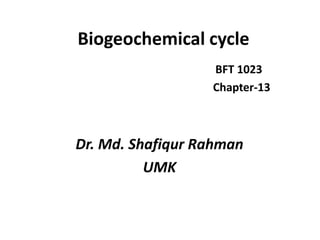
Biogeochemical cycle
- 1. Biogeochemical cycle BFT 1023 Chapter-13 Dr. Md. Shafiqur Rahman UMK
- 2. Biogeochemical cycles biogeochemical cycle, any of the natural circulation pathways of the essential elements of living matter. These elements in various forms flow from the nonliving (abiotic) to the living (biotic) components of the biosphere and back to the nonliving again. In order for the living components of a major ecosystem (e.g., a lake or forest) to survive, all the chemical elements that make up living cells must be recycled continuously.
- 3. Biogeochemical cycles Each cycle can be considered as having a reservoir (nutrient) pool—a larger, slow- moving, usually abiotic portion—and an exchange (cycling) pool—a smaller but more active portion concerned with the rapid exchange between the biotic and abiotic aspects of an ecosystem.
- 4. Biogeochemical cycles Biogeochemical cycles can be classed as gaseous, in which the reservoir is the air or the oceans (via evaporation), and sedimentary, in which the reservoir is the Earth’s crust. Gaseous cycles include those of nitrogen, oxygen, carbon, and water; sedimentary cycles include those of iron, calcium, phosphorus, and other more earthbound elements.
- 5. Biogeochemical cycles Gaseous cycles tend to move more rapidly than do the sedimentary ones and to adjust more readily to changes in the biosphere because of the large atmospheric reservoir. Local accumulations of carbon dioxide, for example, are soon dissipated by winds or taken up by plants. Extraordinary and more frequent local disturbances can, however, seriously affect the capacity for self- adjustment.
- 6. Biogeochemical cycles Plants and some animals obtain their nutrient needs from solutions in the environment. Other animals acquire the bulk of their needs from the plants and animals that they consume. After the death of an organism, the elements fixed in its body are returned to the environment through the action of decay organisms and become available to other living organisms again.
- 7. Biogeochemical cycles Biogeochemical Cycle : the cycling of chemical elements required by life between the living and nonliving parts of the environment. Some examples of these chemical elements are H2O, P, S, N2, O2 and C. Or Biogeochemical cycles: the movement (or cycling) of matter through a system
- 8. Biogeochemical Cycle These elements cycle in either a gas cycle or a sedimentary cycle; some cycle as both a gas and sediment.
- 9. Biogeochemical Cycle Gas Cycles: Sedimentary Carbon Phosphorus Nitrogen Sulfur Oxygen
- 10. Biogeochemical Cycle • In a gas cycle elements move through the atmosphere. Main reservoirs are the atmosphere and the ocean. • In a sedimentary cycle elements move from land to water to sediment. Main reservoirs are the soil and sedimentary rocks.
- 11. Biogeochemical cycles In general... we can subdivide the Earth system into: atmosphere hydrosphere lithosphere biosphere
- 12. Biogeochemical cycles Elements (carbon, nitrogen, oxygen) or molecules (water) so the movement of matter (for example carbon) between these parts of the system is, practically speaking, a biogeochemical cycle
- 13. Biogeochemical cycles The Cycling Elements: macronutrients : required in relatively large amounts "big six": carbon hydrogen oxygen nitrogen phosphorous sulfur
- 14. Biogeochemical cycles other macronutrients: potassium calcium iron magnesium
- 15. Biogeochemical cycles micronutrients : required in very small amounts, (but still necessary) boron (green plants) copper (some enzymes) molybdenum (nitrogen-fixing bacteria)
- 16. Biogeochemical cycles Biogeochemical cycles are part of the larger cycles that describe the functioning of the whole Earth (not just the surface parts)
- 17. Biogeochemical cycles Geological cycle consists of: tectonic cycle rock cycle hydrologic cycle biogeochemical cycles
- 18. Biogeochemical cycles The hydrologic cycle and the biogeochemical cycles. These are the cycles in which humans interact the most
- 21. The carbon cycle The carbon cycle is one of the most important to humans because it is important to our existence: -- one of the primary elements forming human tissues -- necessary to plants, the basis of human food and because it is important to the climate system which sets the background for our environment: -- carbon dioxide (CO 2 ) and methane (CH 4 ) are greenhouse gases which help set global temperatures
- 22. Biogeochemical cycles photosynthesis is the basis of life on Earth... carbon dioxide + water + sunlight _ organic material (sugar) + oxygen -- respiration is the reverse of photosynthesis... organic material + oxygen = carbon dioxide + water + energy animals and plants respire, releasing energy for other activities... decay is also a form of respiration
- 23. Biogeochemical cycles Introduction to the Nitrogen Cycle Important cycle because: -- nitrogen is a necessary nutrient -- nitrogen is part of acid rain
- 24. Biogeochemical cycles The Phosphorus Cycle Important because: -- Phosphorus is a necessary, limiting nutrient -- Phosphate runoff causes eutrophication Phosphorous is a strongly limiting nutrient because it cannot be transferred from the ocean to plants very effectively.
- 25. Basic Concepts in Nutrient Cycling Movement through the atmosphere is generally rapid -- Movement through the soils is generally slow -- Movement from terrestrial biosphere to the ocean (via stream flow, usually) must be replaced by movement either through the atmosphere (such as with nitrogen and carbon) or by weathering (such as with phosphorous or calcium).
- 26. Biogeochemical cycles Humans clearly disrupt many, if not all biogeochemical cycles...and in the process threaten many ecosystems. In the absence of humans, are the biogeochemical cycles stable? Probably not... Life has existed for about 3.5 billion years, and a complete breakdown has not occurred since oxygen became available about 1.5 billion years ago. Change is a part of natural biogeochemical cycles resulting in periods of abundant biota and periods of scarce biota (both ocean and land).
